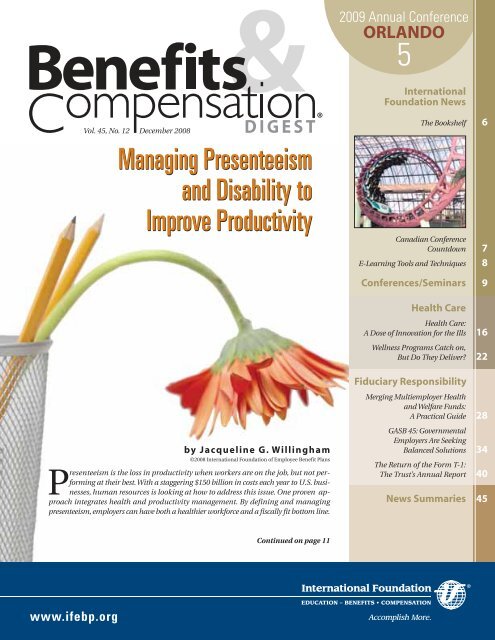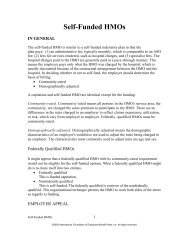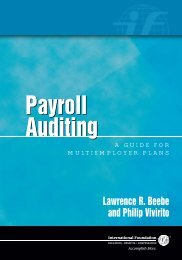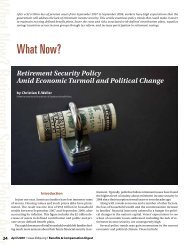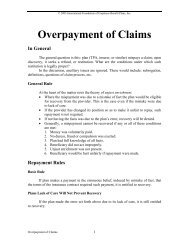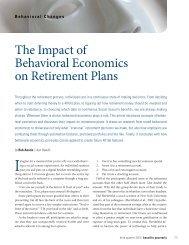Managing Presenteeism and Disability to Improve Productivity ...
Managing Presenteeism and Disability to Improve Productivity ...
Managing Presenteeism and Disability to Improve Productivity ...
You also want an ePaper? Increase the reach of your titles
YUMPU automatically turns print PDFs into web optimized ePapers that Google loves.
2009 Annual Conference<br />
ORLANDO<br />
5<br />
Vol. 45, No. 12 December 2008<br />
<strong>Managing</strong> <strong>Presenteeism</strong><br />
<strong>and</strong> <strong>Disability</strong> <strong>to</strong><br />
<strong>Improve</strong> <strong>Productivity</strong><br />
®<br />
International<br />
Foundation News<br />
The Bookshelf 6<br />
Canadian Conference<br />
Countdown 7<br />
E-Learning Tools <strong>and</strong> Techniques 8<br />
Conferences/Seminars 9<br />
Health Care<br />
Health Care:<br />
A Dose of Innovation for the Ills 16<br />
Wellness Programs Catch on,<br />
But Do They Deliver? 22<br />
by Jacqueline G. Willingham<br />
©2008 International Foundation of Employee Benefit Plans<br />
<strong>Presenteeism</strong> is the loss in productivity when workers are on the job, but not performing<br />
at their best.With a staggering $150 billion in costs each year <strong>to</strong> U.S. businesses,<br />
human resources is looking at how <strong>to</strong> address this issue. One proven approach<br />
integrates health <strong>and</strong> productivity management. By defining <strong>and</strong> managing<br />
presenteeism, employers can have both a healthier workforce <strong>and</strong> a fiscally fit bot<strong>to</strong>m line.<br />
Fiduciary Responsibility<br />
Merging Multiemployer Health<br />
<strong>and</strong> Welfare Funds:<br />
A Practical Guide 28<br />
GASB 45: Governmental<br />
Employers Are Seeking<br />
Balanced Solutions 34<br />
The Return of the Form T-1:<br />
The Trust’s Annual Report 40<br />
News Summaries 45<br />
Continued on page 11<br />
www.ifebp.org
<strong>Managing</strong> <strong>Presenteeism</strong> <strong>and</strong> <strong>Disability</strong><br />
Continued from page 1<br />
lated issues like financial troubles, family<br />
issues <strong>and</strong> workplace conditions.<br />
Why Study <strong>Presenteeism</strong>?<br />
HEALTH CARE—<br />
ADDITIONAL<br />
Resources<br />
Wellness, health, productivity <strong>and</strong> absence<br />
management are all popular <strong>to</strong>pics<br />
with human resources professionals<br />
struggling <strong>to</strong> manage expenses while protecting<br />
the health <strong>and</strong> productivity of their<br />
employees. Tighter budgets <strong>and</strong> a slowing<br />
economy have companies searching for<br />
ways <strong>to</strong> keep costs down in the face of<br />
ever-rising health care premiums. One<br />
component of increased costs that is often<br />
overlooked is presenteeism.<br />
What Is <strong>Presenteeism</strong>?<br />
Though presenteeism in the workplace<br />
has existed for many years, the term has<br />
only been recently defined. In 1994, Professor<br />
Cary Cooper, a psychologist specializing<br />
in organizational management,<br />
coined presenteeism <strong>to</strong> describe workers<br />
who remain on the job but who are not as<br />
productive as usual due <strong>to</strong> illness, stress or<br />
any other type of distraction.<br />
In recent years, human resources experts<br />
have turned their attention <strong>to</strong>ward<br />
refining the definition further in order <strong>to</strong><br />
determine employee behaviors caused by<br />
presenteeism. According <strong>to</strong> the Health<br />
<strong>and</strong> <strong>Productivity</strong> Toolkit from the American<br />
College of Occupational <strong>and</strong> Environmental<br />
Medicine, manifestations of<br />
presenteeism can include:<br />
• Additional time on tasks<br />
• Decreased quality of work<br />
• Impaired executive functions (i.e., initiative)<br />
• Lowered capacity of peak performance<br />
• Decreased quantity of work completed<br />
• Impaired social functioning with<br />
co-workers<br />
• Decreased motivation.<br />
Though this list includes many manifestations<br />
of presenteeism, the list is not<br />
exhaustive, <strong>and</strong> certainly not every listed<br />
item applies <strong>to</strong> every situation. However,<br />
the list does demonstrate the various <strong>and</strong><br />
vast ways that presenteeism can affect<br />
employee productivity.<br />
The causes of presenteeism cover a<br />
broad spectrum—from health-related issues<br />
like allergies, depression, diabetes <strong>and</strong><br />
even the common cold <strong>to</strong> non-health-re-<br />
Tracking <strong>and</strong> managing incidents of absenteeism,<br />
chronic absence from work, has<br />
long been a focus of employers. However,<br />
studies show that presenteeism actually accounts<br />
for more lost time. The Integrated<br />
Benefits Institute says that presenteeism<br />
is responsible for 74% of health-related<br />
lost time, while absenteeism accounts for<br />
only 26%.<br />
One of the reasons employers have<br />
been more cognizant of absenteeism<br />
is that they can account for actual costs<br />
associated with sick pay, salary continuation,<br />
workers’ compensation, short- <strong>and</strong><br />
long-term disability <strong>and</strong> family/medical<br />
leave. While absenteeism is important,<br />
researchers now say presenteeism can be<br />
more costly <strong>to</strong> businesses.<br />
Estimates show that presenteeism<br />
costs U.S. businesses upwards of $150<br />
billion each year—costs incurred from<br />
reduced production, poor cus<strong>to</strong>mer service,<br />
lost sales opportunities, deferred<br />
projects <strong>and</strong> profit reductions. According<br />
<strong>to</strong> the Institute for Health <strong>and</strong> <strong>Productivity</strong>,<br />
presenteeism accounts for 60% of the<br />
<strong>to</strong>tal cost of employee illness. If left unaddressed,<br />
presenteeism may also lead <strong>to</strong><br />
absenteeism.<br />
<strong>Presenteeism</strong> Today,<br />
<strong>Disability</strong> Tomorrow<br />
One of the main health-related causes<br />
of presenteeism is chronic illness, such<br />
as asthma, diabetes <strong>and</strong> arthritis. The<br />
impact of a chronic illness in the workplace<br />
goes beyond presenteeism—it<br />
often leads <strong>to</strong> disability. In fact, according<br />
<strong>to</strong> the U.S. Census Bureau in 2004,<br />
chronic conditions are the leading cause<br />
of disability. With <strong>to</strong>day’s workforce<br />
growing older, more <strong>and</strong> more employees<br />
are prone <strong>to</strong> disabilities. With the link<br />
between health-related presenteeism<br />
<strong>and</strong> disability, researchers <strong>and</strong> companies<br />
have even more reason <strong>to</strong> examine<br />
presenteeism more closely.<br />
Measuring <strong>Presenteeism</strong><br />
Even though presenteeism is costly <strong>to</strong><br />
Continued on next page<br />
More Information<br />
Members can:<br />
• Go <strong>to</strong> www.ifebp.org/infoquick.<br />
• Enter an e-mail address in the box<br />
provided.<br />
• Under “General Benefits,” check the<br />
box at “<strong>Presenteeism</strong>.”<br />
• Click on “send” <strong>and</strong> resources will be<br />
e-mailed instantaneously.<br />
[!]<br />
Got a specific benefits question?<br />
Need some help answering it?<br />
Call (888) 334-3327, option 5, <strong>and</strong><br />
get a prompt e-mail or fax back.<br />
Conferences <strong>and</strong> Seminars<br />
E-Learning Course<br />
Are You Present:<br />
What’s Happening in<br />
Absence Management?<br />
For more information, view<br />
www.ifebp.org/elearning.<br />
Book<br />
Platinum Book:<br />
Practical Applications of the Health<br />
<strong>and</strong> <strong>Productivity</strong> Management Model<br />
Joseph Leutzinger, Sean Sullivan <strong>and</strong><br />
Larry Chapman (Institute for Health <strong>and</strong><br />
<strong>Productivity</strong> Management). 140 pages.<br />
Item #8505. $72. For more book details,<br />
see www.ifebp.org/books.asp?8505.<br />
To order, call (888) 334-3327, option 4.<br />
HEALTH CARE ▼<br />
December 2008 • www.ifebp.org • Benefits & Compensation Digest 11
Figure 1<br />
Health-Related Lost Time:<br />
What’s the Primary Source?<br />
a large investment of time, money <strong>and</strong><br />
resources. Perhaps this is why only 14%<br />
of employers are addressing presenteeism.<br />
Actually, there are various practical<br />
<strong>and</strong> cost-effective ways <strong>to</strong> manage<br />
presenteeism that reduce lost time <strong>and</strong><br />
improve employee productivity. Indeed,<br />
even small changes will create improvements.<br />
Educating the Workforce<br />
Source: The Business Value of Health: Linking CFOs <strong>to</strong> Health <strong>and</strong> <strong>Productivity</strong>,<br />
Integrated Benefits Institute, May 2006.<br />
businesses, a joint study conducted by the<br />
Benfield Group <strong>and</strong> the American College<br />
of Occupational <strong>and</strong> Environmental Medicine<br />
found that only 14% of companies<br />
are studying <strong>and</strong> dealing with presenteeism.<br />
It is extremely important that human<br />
resources experts learn how <strong>to</strong> effectively<br />
measure presenteeism within their workforce.<br />
There are several survey <strong>to</strong>ols used<br />
<strong>to</strong> measure lost productive time. Three of<br />
the most commonly used <strong>to</strong>ols are the<br />
American <strong>Productivity</strong> Audit, the WHO<br />
Health <strong>and</strong> Work Performance Questionnaire<br />
<strong>and</strong> the Work Limitations Questionnaire.<br />
Developed by Dr. Walter “Buzz” Stewart,<br />
the American <strong>Productivity</strong> Audit consists<br />
of 46 questions that ask respondents<br />
how much productive time they lost because<br />
of medical problems.<br />
Dr. Ron Kessler of Harvard Medical<br />
School developed the world health organization<br />
(WHO) questionnaire titled WHO<br />
Health <strong>and</strong> Work Performance Questionnaire<br />
(HPQ). The HPQ addresses both absenteeism<br />
<strong>and</strong> presenteeism with 30<br />
questions asking respondents <strong>to</strong> assess<br />
their overall work experience during the<br />
previous four weeks. The HPQ tends <strong>to</strong> be<br />
popular among smaller employers.<br />
The Work Limitations Questionnaire<br />
was designed by Dr. Debra Lerner from<br />
Tufts University. The survey consists of 25<br />
questions <strong>and</strong> measures how an illness<br />
can impact a respondent’s ability <strong>to</strong> function<br />
under job dem<strong>and</strong>s.<br />
Because employers may not be familiar<br />
with what types of questions they should<br />
ask their employees <strong>to</strong> best measure productivity,<br />
these surveys are great <strong>to</strong>ols for<br />
employers that want <strong>to</strong> create a baseline<br />
productivity assessment of their workforce.<br />
<strong>Managing</strong> <strong>Presenteeism</strong>:<br />
Well Beyond a Wellness Program<br />
Once an employer defines presenteeism<br />
within a business, health <strong>and</strong> productivity<br />
management come in<strong>to</strong> play.<br />
It is increasingly well unders<strong>to</strong>od that<br />
managing health risks, chronic illnesses<br />
<strong>and</strong> disability reduces employees’ <strong>to</strong>tal<br />
health-related costs, such as direct medical<br />
expenditures, unnecessary absence<br />
from work <strong>and</strong> lost performance on the<br />
job.<br />
The most common approach <strong>to</strong> dealing<br />
with presenteeism is health promotion<br />
using wellness programs. Many employers<br />
provide health fairs, screenings<br />
<strong>and</strong> health risk appraisals <strong>to</strong> assess the<br />
needs of employees.<br />
Another, more far-reaching <strong>and</strong> more<br />
effective way <strong>to</strong> deal with presenteeism<br />
is <strong>to</strong> integrate the management of health<br />
risks, chronic illness, disability <strong>and</strong> presenteeism.<br />
In addition <strong>to</strong> a wellness program,<br />
this approach involves examining<br />
<strong>to</strong>tal benefits offerings <strong>and</strong> reconsidering<br />
policies <strong>and</strong> procedures, keeping in mind<br />
the causes—both health related <strong>and</strong> nonhealth<br />
related—of presenteeism.<br />
An integrated approach should include<br />
a wellness program as one of its<br />
components, but it should also address<br />
education, company culture, employee<br />
assistance programs, benefit plan design,<br />
return-<strong>to</strong>-work (RTW) programs <strong>and</strong><br />
even vendor relationships. Many believe<br />
that implementing this approach involves<br />
Education may seem like an obvious<br />
<strong>to</strong>pic, but Watson Wyatt recently noted in<br />
its Staying at Work study that only 19% of<br />
companies regularly engage in communication<br />
about disability, health <strong>and</strong> productivity<br />
management. This is despite evidence<br />
that employee education reduces<br />
costs.<br />
Education is one of the easiest, least<br />
expensive <strong>and</strong> most important steps in<br />
addressing presenteeism. Even if a company<br />
does not have a wellness program,<br />
education should still take place. Employers<br />
should work <strong>to</strong> ensure employees are<br />
aware of the most common lifestyle fac<strong>to</strong>rs<br />
<strong>and</strong> chronic conditions that contribute<br />
<strong>to</strong> illness <strong>and</strong> disability. In addition,<br />
employers should identify ways they<br />
can aid employees in leading healthy <strong>and</strong><br />
productive lives.<br />
Employers can use mailers, posters, intranet<br />
pages, flyers, newsletters, educational<br />
workshops <strong>and</strong> e-mails <strong>to</strong> keep<br />
employees informed. For example, an employer<br />
can display a poster that reminds<br />
employees <strong>to</strong> cover their mouths when<br />
they sneeze <strong>and</strong> <strong>to</strong> regularly wash their<br />
h<strong>and</strong>s <strong>to</strong> prevent the spread of germs <strong>and</strong><br />
illness. Or an employer can set up a “bike<br />
<strong>to</strong> work” program <strong>to</strong> engage their employees<br />
in healthy activities <strong>and</strong> encourage<br />
their employees <strong>to</strong> participate. These are<br />
just two examples of easy <strong>and</strong> cost-effective<br />
ways <strong>to</strong> educate the workforce <strong>and</strong><br />
manage presenteeism.<br />
Valuing Health <strong>and</strong> <strong>Productivity</strong><br />
Company culture is another fac<strong>to</strong>r <strong>to</strong><br />
examine when addressing presenteeism.<br />
Does the company culture value health<br />
<strong>and</strong> productivity? Is the established attendance<br />
management program effective or<br />
detrimental <strong>to</strong> employee health <strong>and</strong> productivity?<br />
A U.K. study looked at presenteeism <strong>and</strong><br />
absenteeism in employees with chronic<br />
12 December 2008 • www.ifebp.org • Benefits & Compensation Digest
health conditions versus employees without<br />
chronic health conditions. The study<br />
consisted of 1,474 employees with<br />
chronic health conditions <strong>and</strong> 3,790 employees<br />
without chronic health conditions.<br />
The employees were from four different<br />
organizations in both the public<br />
<strong>and</strong> private sec<strong>to</strong>rs. All of the companies<br />
had attendance management <strong>and</strong> RTW<br />
programs in place.<br />
The study found that the companies’<br />
absence management policies encouraged<br />
employees with chronic health conditions<br />
<strong>to</strong> return <strong>to</strong> work so they would not face<br />
disciplinary measures. The result: additional<br />
episodes of presenteeism. So, while<br />
the companies thought they were reducing<br />
costs by addressing absences, their<br />
policies simply shifted the problem from<br />
absenteeism <strong>to</strong> presenteeism.<br />
When thinking about company policies,<br />
some questions <strong>to</strong> consider are:<br />
• Do employees feel pressured <strong>to</strong> come<br />
<strong>to</strong> work when they are not feeling<br />
well?<br />
• Do absence management policies<br />
lead <strong>to</strong> presenteeism?<br />
• What is the general awareness of the<br />
prevalence of chronic health conditions<br />
in the workplace?<br />
• What does the company do <strong>to</strong> ensure<br />
employees who have returned <strong>to</strong> work<br />
are not experiencing presenteeism?<br />
Addressing Non-Health-Related<br />
<strong>Presenteeism</strong><br />
Figure 2<br />
Relationship Between Prescription Purchase <strong>and</strong> Price<br />
Source: The Impact of Pharmacy Plan Design, Integrated Benefits Institute,<br />
2007.<br />
To help employers manage nonhealth<br />
<strong>and</strong> mental health presenteeism problems,<br />
companies should encourage utilization<br />
of employee assistance programs<br />
(EAPs). EAPs are confidential, nonthreatening<br />
resources that many companies get<br />
as an added benefit from their disability<br />
or health insurance carrier. EAPs offer employers<br />
a broad range of services, from<br />
implementing wellness programs <strong>to</strong> crisis<br />
management. In addition, EAPs can assist<br />
employees with a wide range of issues that<br />
could have an impact on their productivity<br />
<strong>and</strong> health, such as emotional stress,<br />
mental health conditions, marital or family<br />
problems, financial concerns or substance<br />
abuse issues.<br />
Typically, EAP counselors provide employees<br />
with assessments, support <strong>and</strong>, if<br />
needed, referrals <strong>to</strong> additional resources<br />
<strong>and</strong> health professionals. It is imperative <strong>to</strong><br />
respect the privacy of employees—managers<br />
<strong>and</strong> supervisors should not directly<br />
instruct employees <strong>to</strong> utilize an EAP. However,<br />
managers <strong>and</strong> supervisors should<br />
work <strong>to</strong> raise awareness about EAPs as a resource<br />
that can help resolve problems that<br />
may be interfering with job performance.<br />
Do the Components Add Up?<br />
Another key <strong>to</strong> addressing presenteeism<br />
is examining the overall design of the benefits<br />
portfolio. By regularly examining benefits<br />
plans <strong>and</strong> offerings, employers can<br />
make more appropriate <strong>and</strong> effective benefits<br />
investments.<br />
In 2007, the Integrated Benefits Institute<br />
conducted a large study of rheuma<strong>to</strong>id<br />
arthritis patients. The study included<br />
more than 5,000 employees— 41%<br />
male <strong>and</strong> 59% female—from all across the<br />
United States. As shown in Figure 2, the<br />
study found that 64% of the patients filled<br />
prescriptions for symp<strong>to</strong>m-relieving drugs<br />
<strong>and</strong> 45% filled prescriptions for diseasemodifying<br />
drugs, with purchase rates<br />
dropping off as the prescriptions increased<br />
in price.<br />
One of the key findings was that more<br />
than half the workers with rheuma<strong>to</strong>id<br />
arthritis were not taking their drugs,<br />
mostly because they considered the ou<strong>to</strong>f-pocket<br />
expenses <strong>to</strong>o high. The result<br />
was an untreated chronic illness that contributed<br />
<strong>to</strong> presenteeism.<br />
While it is still wise <strong>to</strong> share costs with<br />
employees through voluntary, supplemental<br />
or buy-up benefits options, employers<br />
that shift <strong>to</strong>o much of the cost burden <strong>to</strong><br />
employees may end up losing more than<br />
they save when the cost of lost productivity<br />
is added <strong>to</strong> the equation. This problem<br />
is especially relevant now, as employees<br />
are feeling the economic tug at the gas station<br />
<strong>and</strong> grocery s<strong>to</strong>re as well as at a doc<strong>to</strong>r’s<br />
office.<br />
Equally important during this current<br />
economic downturn is a company’s overall<br />
benefits package. Benefits offerings are<br />
extremely valuable <strong>to</strong> employees during<br />
times of economic hardships—they allow<br />
employers <strong>to</strong> demonstrate their commitment<br />
<strong>to</strong> their employees. Offering robust<br />
benefits packages also helps <strong>to</strong> retain talent,<br />
attract new employees <strong>and</strong> demonstrate<br />
goodwill.<br />
A Positive <strong>Disability</strong> Outcome<br />
As previously noted, the risk of disability<br />
is increasing due <strong>to</strong> the aging of the workforce.<br />
Rising disability claims could pose a<br />
growing challenge as labor shortages put<br />
more pressure on employers <strong>to</strong> keep as<br />
many people at work as they can. A comprehensive<br />
health <strong>and</strong> productivity management<br />
program can reduce incidences of<br />
Continued on next page<br />
HEALTH CARE ▼<br />
December 2008 • www.ifebp.org • Benefits & Compensation Digest 13
disability, but it is never possible <strong>to</strong> completely<br />
eradicate disability. Companies<br />
should look at how <strong>to</strong> maximize their RTW<br />
programs. Helping disabled employees return<br />
<strong>to</strong> a productive role in the workplace<br />
<strong>and</strong> ensuring that employees who have returned<br />
maintain their productivity can result<br />
in significant savings for employers.<br />
When working <strong>to</strong> help a disabled employee<br />
return <strong>to</strong> work, there are three key<br />
steps that an employer <strong>and</strong> a disability<br />
carrier should take. First, the carrier works<br />
with the employee <strong>and</strong> his or her physician<br />
<strong>to</strong> assess the employee’s readiness for<br />
beginning a transition back <strong>to</strong> work. Second,<br />
the carrier <strong>and</strong> employer develop a<br />
plan that will meet the employee’s needs<br />
<strong>and</strong> will be supported by his or her physician.<br />
This plan can include establishing<br />
time frames, making workspace accommodations<br />
<strong>and</strong> providing training if the<br />
employee returns <strong>to</strong> a new role. Finally,<br />
the carrier moni<strong>to</strong>rs the plan using set review<br />
points <strong>to</strong> ensure that the transition is<br />
proceeding smoothly <strong>and</strong> that there are<br />
no setbacks or snags.<br />
Use the Experts<br />
Today’s economy is impacting everyone’s<br />
budgets, so why invest more money<br />
without first taking advantage of existing<br />
resources? Exploring existing relationships<br />
with vendors <strong>and</strong> partners is another component<br />
of an integrated approach. Companies<br />
should look <strong>to</strong> current resources<br />
<strong>and</strong> partners <strong>to</strong> see how each can improve<br />
the overall workplace atmosphere.<br />
Vendors <strong>and</strong> partners can help:<br />
• Identify trends specific <strong>to</strong> an industry<br />
or business <strong>and</strong> offer trend analyses<br />
<strong>to</strong> help map a direction for health <strong>and</strong><br />
productivity improvements.<br />
• Provide information about the chronic<br />
conditions affecting employees.<br />
• Compile data regarding health <strong>and</strong><br />
productivity of the workplace.<br />
• Offer counseling <strong>and</strong> employee assistance<br />
program services.<br />
• Conduct education workshops.<br />
• Build a wellness program.<br />
• Conduct productivity surveys or<br />
health risk appraisals.<br />
• <strong>Improve</strong> benefits design plans.<br />
• Offer incentives <strong>to</strong> employees.<br />
• Conduct worksite ergonomic assessments.<br />
• Create an RTW program.<br />
• Offer preventive or safety programming,<br />
such as safe driving instruction<br />
or workplace safety training.<br />
The most important thing is <strong>to</strong> determine<br />
the capabilities of vendors <strong>and</strong> partners<br />
<strong>and</strong> work with them <strong>to</strong> make improvements.<br />
Vendors are eager <strong>to</strong> provide<br />
their expertise <strong>to</strong> help employers <strong>and</strong> can<br />
be valuable in identifying <strong>and</strong> recommending<br />
available external resources.<br />
What may be surprising is that many of<br />
these services <strong>and</strong> resources are available<br />
at no additional cost.<br />
Being Proactive Works<br />
Companies that openly value health<br />
<strong>and</strong> productivity will find that their employees<br />
will take action in addressing<br />
presenteeism on an individual level. For<br />
example, a 51-year-old administrative<br />
assistant suffering from multiple sclerosis<br />
worked for a company that valued<br />
employee health. Eventually, her chronic<br />
disease started <strong>to</strong> affect her mobility. She<br />
noticed a drop in her productivity, so<br />
she <strong>to</strong>ok her concerns <strong>to</strong> her employer.<br />
She requested a scooter <strong>to</strong> be used at<br />
home <strong>and</strong> the office—a request her employer<br />
deemed reasonable. The employer<br />
<strong>and</strong> employee then successfully<br />
reached out <strong>to</strong> the local Multiple Sclerosis<br />
Society chapter <strong>to</strong> secure funding for<br />
the scooter. The quick turnaround resulted<br />
in improved productivity <strong>and</strong> no<br />
[<br />
absence. Employers that make health<br />
<strong>and</strong> productivity a priority <strong>and</strong> effectively<br />
communicate that <strong>to</strong> employees<br />
will successfully build a company culture<br />
where employees feel comfortable, safe<br />
<strong>and</strong> valued. These companies will see an<br />
increase in workforce productivity <strong>and</strong><br />
overall satisfaction.<br />
Start With What Is Available<br />
With so many causes <strong>and</strong> manifestations<br />
of presenteeism, how <strong>to</strong> address the<br />
issue might seem overwhelming. The encouraging<br />
news is that employers starting<br />
with small efforts can <strong>and</strong> have seen<br />
huge results. Companies should begin by<br />
measuring the incidences of presenteeism<br />
in the workplace <strong>and</strong> determining<br />
appropriate available resources <strong>to</strong> manage<br />
them. Absence management policies,<br />
awareness of health conditions in the<br />
workplace <strong>and</strong> employee perspectives<br />
should all be considered. Employers<br />
need <strong>to</strong> also ensure that the overall design<br />
of the company’s benefits portfolio<br />
allows them <strong>to</strong> make more effective benefits<br />
investments. Educating the workforce<br />
<strong>and</strong> taking steps <strong>to</strong>ward improving<br />
overall health will help employee accountability<br />
<strong>and</strong> reduce presenteeism as well as<br />
disability. Defining <strong>and</strong> managing presenteeism<br />
on any scale allows employers <strong>to</strong><br />
see a healthier workforce <strong>and</strong> a healthier<br />
financial well-being.<br />
B&C<br />
For information on ordering reprints of this<br />
article, call (888) 334-3327, option 4.<br />
Jacqueline G. Willingham is vice president of benefits in the<br />
insurance services division at St<strong>and</strong>ard Insurance Company. She<br />
is responsible for all claim operations for group <strong>and</strong> individual<br />
disability insurance, group life <strong>and</strong> dental products. Willingham<br />
has 22 years of experience developing <strong>and</strong> managing disability<br />
claim operations <strong>and</strong> other employee benefits functions. She has<br />
led numerous strategic projects <strong>and</strong> process improvement initiatives.<br />
A graduate of Willamette University in Salem, Oregon,<br />
she has served as a leader <strong>and</strong> member of numerous community<br />
organizations in Portl<strong>and</strong>, Oregon <strong>and</strong> Chicago.<br />
[<br />
14 December 2008 • www.ifebp.org • Benefits & Compensation Digest


